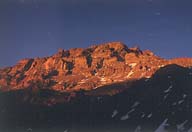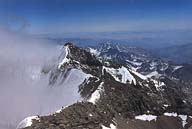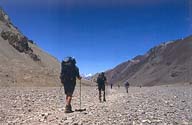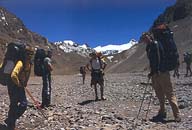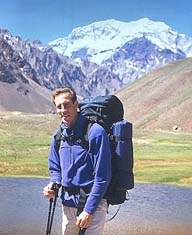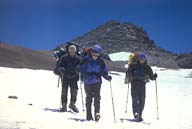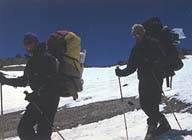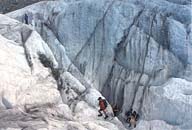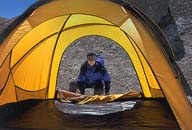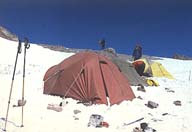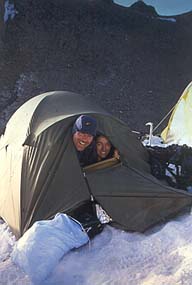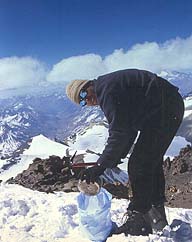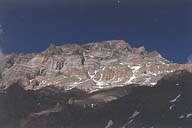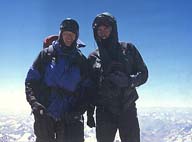Normal is Relative - Climbing Aconcagua by the Normal Route
“Today is the day that we say goodbye to our dignity for the next few days,” Rob’s words from a few days earlier echoed through my mind as I tried to use my pee bottle within the cramped confines of our tent.
With much anxiety at the possibility of things going wrong and not wishing to wake my tent companions, Felix and Rob, I had quietly managed to get myself into position. But having struggled and wriggled to do so I was cruelly struck by stage fright. To add to my problems Felix awoke and seemed worryingly amused by the occasion. However, despite Felix’s best attempts to put me off the task at hand, I managed to coax ‘yours truly’ into action and thankfully my aim was true.
What was ‘normal’ about this? Either the ‘Normal Route’ was a misnomer or Argentineans have a wicked sense of humour. Or perhaps it was just me and I had been naïve to think that there was anything ‘normal’ about trying to climb the highest mountain in the world outside the Himalayas. Perhaps I had been lulled into a false sense of security by the soporific charms of Mendoza, the leafy town at the heart of Argentina’s wine-growing region that we used as a base for our ascent of Aconcagua. Whatever the reason, it was out of the ordinary for a group of city slickers like us to be in such an environment, and rarely has the phrase ‘all the gear and no idea’ been so appropriate.
Our attempt on Aconcagua began at Puenta del Inca on a bright morning without a cloud in sight – an auspicious beginning, or so we hoped. A train of mules arrived to carry all our food and provisions to base camp, whilst a battered old Chevy pick-up truck arrived to meet us. We piled our rucksacks and ourselves into the back of the Chevy and set off to the Park entrance, singing a Chevy-inspired rendition of Don Maclean’s ‘American Pie’.
Arriving at the Park entrance, we duly dispensed with some final formalities and began our three-day walk into base camp. We were in shorts, the sun was bright, our spirits were high and the summit of Aconcagua beckoning to us in the distance seemed almost tame. The scenery was stunning - glacial valleys, sheer cliff faces and the variegated colours of scree slopes all competed for our attention. Our rucksacks were comparatively light, the altitude was not a strain and thus the next three days were light-hearted and enjoyable. That is except for Rob and Felix’s cooking which was neither light nor enjoyable, a case in point being their gravity-defying porridge.
Plaza des Mulas, or Base Camp as it is universally referred to, was a welcome sight and respite for aching shoulders and sore feet. At an altitude of 4,230 metres base camp was more akin to a small village than a camp. Replete with numerous cook houses, dining tents, igloo tents and toilets, the sheer scale of base camp made me realise the logistical nightmare and headache that our leaders, Steve and Craig, had had in trying to organise and prepare for our summit attempt. The secret to climbing Aconcagua lies not in technical but logistical expertise – it is a war of attrition.
The next morning, spoilt by the comparative luxury of base camp and its mess tents, we took an inordinate amount of time in preparing for the day’s acclimatisation walk. Steve reprimanded us for our lack of punctuality and reminded us of the necessity of order and time-keeping on the mountain, especially as we gained altitude. We would not make the same mistake twice.
Over the next few days we had the important task of stocking the camps above and fell into a daily routine. At breakfast we plied ourselves with drinks, mainly hot, in an attempt to warm up and hydrate ourselves. We would then set off crossing a small glacier of tiny peaks which rose together in silent prayer, hence the local name of penitentes, and begin to zigzag upwards, painstakingly placing one foot in front of the other.
Once at the camp we stashed our fuel and food in a stone cache and then rested for an hour to acclimatise. Coming down was blissfully easy in comparison to the uphill slog. With virtually no weight on our backs and a spring in our step, we sailed down the mountain in a third of the time that it had taken us to climb. Back at camp, energy permitting, we would pack and repack our rucksacks, write diaries or wash clothes, the latter being a vain attempt to keep odour levels at an acceptable minimum.
Undoubtedly the hardest day, other than summit day, was the day we had to stock Camp 2. Carrying loads in excess of 50 lbs. over one thousand metres from 4,230 metres to 5,365 metres was ‘gruelling’ and ‘exhausting’ as I described in my journal. But this barely does justice to the pain and weariness that we felt as we struggled under the weight of our rucksacks. Matt – and he will hate me for saying this - really struggled, toiling uphill like an ocean liner wallowing in distress in heavy seas. But despite the altitude and the series of heart-breaking false summits he battled on and like the ‘Terminator’ moved imperceptibly towards the camp.
Trudging up the slope, watching the feet of Scott in front of me, I gave much thought as to why I had forsaken the creature comforts of home for the harsh world of Aconcagua. The stark beauty of the mountains and the physical challenge of being there were obvious draws but the real driving force was the bond that such a challenge forged. By this I mean that I would not have wanted to climb Aconcagua, or any other mountain for that matter, alone. For me it was the friends that I was sharing the experience with that made the whole experience so special.
On the morning that we were to begin our ascent proper, we were all a little shell-shocked. No doubt this was partly because we were about to leave the comforts of base camp but in large part it was due to sleep deprivation – last night the wind had howled with an intensity that none of us had experienced before. It raged all night in a succession of waves and roared like a thousand tigers as it battered our tents relentlessly. Sides flapped and snapped under the strain; zips and poles rattled in a crashing percussive accompaniment. The onslaught was constant and unforgiving and some tents, unable to withstand such a barrage, were shredded. Thankfully all our tents stood firm, which is more than can be said of our resolve.
However our overnight worries were unfounded as Steve and Craig decided that due to the extreme winds and temperature (100mph and –30 C up at Camp 2, one thousand metres above us) we would stay put for today and head off tomorrow. We felt relieved that we did not have to contend with the extreme conditions of today, yet frustrated that we had been delayed. We had a three-day summit window to allow for bad weather and today had used up one of those days, thus reducing the days we had available to summit and possibly our chances of success.
Their decision was vindicated the next day when we awoke to brighter skies – the storm had blown itself out. We set off without delay and arrived at Camp Canada, otherwise known as Camp One, in the early afternoon, immediately pitched our tents and began collecting snow to boil for water. There was an initial sense of fun in collecting snow but the novelty factor quickly wore off and it became a chore that meant leaving the warmth of the tent and required huge effort the higher we got. Although we worked efficiently in our tent groupings it still took us some four hours to collect enough snow, melt it, cook, eat and wash up. Everything takes time at altitude.
At Camp 2, Nido de Condores, whilst there were no nesting condors there were staggering views of the jagged array of snow-capped mountains below and all around us. However we did not have long to appreciate the panoramic view before we had to think about where we would pitch our tents. Fearful of the wind picking up, we opted for a sheltered hollow but this meant pitching our tents on snow. Levelling out a flat area to camp on with ice axes is back-breaking work at the best of times but at over 5,300 metres it was exhausting and quickly dampened our exhilaration of the scenery below us. After yet more hours of boiling water we retired to our tents somewhat deflated.
We awoke to find that there was ice inside the tent. The overnight temperature had dropped to –25 C and thus the condensation from our breath had frozen. Scraping the ice off, before we packed our tents away in our rucksacks, my hands froze – so much so that I had to put them under my armpits for several minutes before I got any sort of feeling back in them. It was a salient lesson for the future.
The Berlin Huts, Camp 3, were the final staging post before the summit. We spent one day stocking Berlin Huts from Camp 2, before moving up there in preparation for our summit attempt. We spent the afternoon trying to rest and conserve energy, but gnawing doubts and nagging headaches plagued us throughout the afternoon and night, hence on the morning of our summit attempt we did not feel at our best.
To make matters worse when the early morning rays first warmed our thermometer, the temperature only rose to –18 C. The question was how much colder had it been in the night and how much colder would it get the higher we climbed? We quickly discovered the answer as the cold began to take its toll. Claire in particular suffered and at one stage we had to stop, take off her boots and try to rub some warmth and sensation into her numbed feet. Later she was able to laugh about the fact that she had had four men massaging her feet but at the time she was in some distress. In fact we were all suffering from the extreme cold and were relieved when Steve said that it would be dangerous to proceed much further and that we should return to Camp 3.
The next day the weather was much brighter and so too our spirits. We were much better prepared both mentally and physically than yesterday and set off with a real sense of purpose, but unfortunately without Claire and Craig who had fallen victim to the altitude and were confined to their tents. Our ascent was steady and without incident until we crossed the Cresta de Viento, which as its name suggests was exposed and windy. We were now at the bottom of the Canaleta, an infamous 400 metre steep climb up scree. This may not sound like much but at almost 6,500 metres it felt like walking in porridge and was shattering. It was a gruelling test of strength, both mental and physical, and required all our drive and determination to overcome the fatigue and shortness of breath and keep trudging upwards. Our progress was painfully slow.
For Scott the Canaleta was sadly the final straw. Weakened by a dose of the squits (later diagnosed as Giardia) he was sapped of all energy and had nothing left in reserve. He was very emotional at not being able to summit and also due to the fact that I as his ‘buddy’ would have to go back down with him to ensure that he was OK. I was disappointed that I was being denied the opportunity to summit but Scott’s safety was paramount.
Scott and I were about to head back when Matt
selflessly said that he would go down with Scott. Matt was evidently
drained and doubted his
own ability to reach the summit but with the luxury of hindsight I think
that he perhaps had enough in him to make it – he is incredibly
stubborn. Irrespective of whether Matt could have made the summit, his
offer was incredibly generous and encapsulated the whole spirit and camaraderie
of the group.
Rob, Felix, Steve and I battled on and eventually reached the summit
at 3.30 p.m. after a climb of eight and a half-hours. We were emotional
and exhausted but ecstatic. At an altitude of 6,962 metres we were
higher than any of us had been before, at the highest point outside
of the Himalayas. Suddenly the monotony and the pain of the last few
hours were forgotten and we revelled in the fact that we had the Andes
at our feet. It was a very moving moment, all the more poignant because
not all of us were there.
Unfortunately the altitude was as breathtaking as the scenery and before long we had to head back down. Descending the Canaleta on tired and wobbly legs was treacherous and we stumbled and fell several times, making hard work of it but the thought of hot food and sleep back at the Berlin Huts was a powerful incentive. Thus almost four hours later, dirty, drained yet delighted we arrived back at Camp 3. We only managed some soup noodles before we were overcome by tiredness and crawled into our sleeping bags.
The following morning, the recuperative effects of sleep, food and the prospect of heading back to civilisation – in the form of Puenta del Inca guesthouse – were amazing and we romped downhill with renewed energy and gusto. The speed of our descent may also have been due to the fact that we were bringing all our rubbish down, which was beginning to get a little high. Whatever the reason, in just a few days we made it back to Mendoza, where we were able to drink in its delights, both literally and metaphorically.
The whole expedition had been tough, uncomfortable
and demanding – ‘enjoyment’ had
not featured much in our daily vocabulary. Despite this it was a fantastic
experience and certainly a memorable one. In reaching the summit we had
accomplished something beyond the spheres of our everyday lives. There
had been nothing ‘normal’ about the route that we had taken
let alone about climbing Aconcagua.
|
|
|
